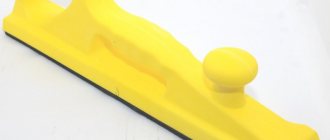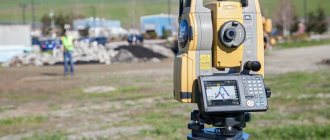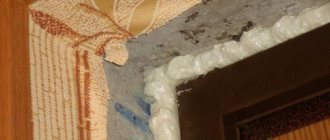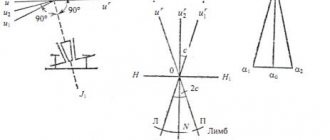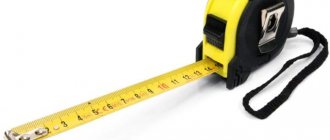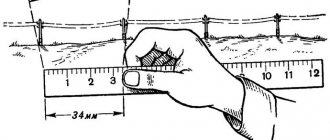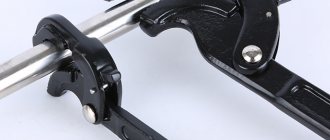A protractor is a mathematical tool consisting of a ruler and a semicircle divided into degrees from 0 to 180°. It is used to measure and plot angles in drawing and mathematical drawing, along with graphing in physics. Learning to use a protractor is quite simple.
People usually encounter protractors in mathematics when they learn to create precise geometric shapes in school. Many of them may never have a reason to use these devices again, but protractors have a long history of use in a variety of applications.
History of invention
The origins of this mathematical instrument go back to the priests in Egypt and Babylon, who established the measure of angles in degrees, minutes and seconds. However, trigonometry was not used in mathematics until the times of classical Greece.
In the second century BC, the astronomer Hipparchus of Nikia invented a trigonometric table for measuring triangles. Then Ptolemy included in his great astronomical book, Almagest, a table with angular increments from 0 to 180°, with an error of less than 1/3600 units. He also explained the method for constructing this table, and throughout the book he gave many examples of how to calculate unknown elements of figures using it.
Ptolemy was also the author of the so-called Menelaus theorem for solving spherical triangles, and for many centuries his trigonometry was the main tool for astronomers.
Perhaps at the same time, the scientists of India also developed a trigonometric system based on the sine function, which, unlike the sine currently used, was not a proportion, but the length of the side opposite the angle in the right triangle of that hypotenuse. Indian mathematicians used different meanings for this in their tables.
Thomas Blundeville spoke about a device specially created for drawing and measuring figures in his “A Brief Description of Universal Charts” of 1589. As the name suggests, he used it to edit navigational charts for use in high latitudes.
Other European mathematicians also described similar devices around the same time. Regardless of who first invented the instrument, by the early 17th century it had become standard practice for navigators and surveyors. By the 18th century, protractors began to appear in textbooks on surveying and geometry.
Protractors in the modern sense arose in the second half of the 18th century, when scientists such as Jesse Ramsden and Georg Friedrich Brander improved previously created devices.
At that time, the preferred materials for their manufacture were:
- tree;
- brass;
- silver;
- copper;
- Ivory.
In the first half of the 20th century, tin and celluloid began to be used.
The device began to be called a protractor (Russian) in 1610. The term comes from the medieval word protractor, meaning “to carry,” which in turn comes from the Latin word protrahere, “to pull forward.”
Introduction
Some things can be measured, some cannot. For example, friendship or love cannot be measured. And distance, weight, temperature are quite possible. To measure something, everyone needs to agree on the units of measurement. Meter, inch, arshin - these are the conventions for measuring length. The standard meter is kept in France, in the Chamber of Weights and Measures. Kilogram, pound, pood are conventions for measuring mass. The standard kilogram is also kept in the Chamber of Weights and Measures.
Units of measurement are invented for specific quantities. Weight cannot be measured in seconds, but time cannot be measured in arshins.
The situation is the same in geometry. There are centimeters for measuring the lengths of segments, but they are not suitable for measuring angles. There are different units of measurement for measuring angles. In this lesson we will look at one of them, namely degrees.
Varieties and uses
A protractor is a simple goniometer for measuring or creating an angle. It looks like a round or semicircular disk with divisions. The disk can be made of plastic, durable paper, or sheet metal. Typical diameters are from 8 to 15 cm and divisions of 1° and 0.5°, also measuring 0.5 Gon (new degree). The accuracy ranges from 0.1 to 0.5° depending on the scale diameter. More precise instruments have a rotating rod with a scale (length up to a millimeter).
Partly because of their varied uses they are made in many shapes : the familiar semicircle, but also circles, rectangles, squares, or quarter circles (quadrants). They can also have different diameters. They are made from brass, steel, wood, ivory or plastic. The most common shape is a semicircle with a limiting scale of 180 degrees.
An Angle Protractor is a graduated round instrument with one rotating arm; used for measuring or marking. In construction, it is often necessary to measure an angle of 90 degrees. Sometimes a Vernier scale is included to give a more accurate reading. The instrument is widely used for producing architectural and mechanical drawings, although its use has declined with the advent of modern drawing software.
Universal bevel protractors are used by toolmakers; Since they make measurements through mechanical contact with an object, they are classified as mechanical protractors.
The angle protractor is used to measure and check angles with very tight tolerances. It reads up to 5 arcminutes (5 or 1/12°) and can measure from 0 to 360°.
Today, electronic devices are also used, which usually work with a rotary encoder. In addition, devices associated with the protractor are:
- theodolite;
- optical protractor in the construction industry and geodesy;
- inclinometer for determining slopes and indirect altimetry;
- sextant for navigation.
Choice
Today, manufacturers provide a huge selection of office supplies, including protractors. Tools are made in a variety of colors; protractors in bright colors are traditionally in demand among schoolchildren. Everyone chooses shapes and sizes to their own taste. Most of these products are made of plastic, and this significantly reduces its cost. But there are wooden and even iron protractors. As practice shows, despite the fact that metal ones are opaque, they are more practical because the scale does not erase, and this allows you to use the tool much longer without replacing it with a new one.
Measuring Angle Degrees
In order to learn how to use a protractor, instructions are needed at the initial stage. To master it, just a few minutes and examples (look online) of how you can measure and construct an angle using this device are enough.
To measure an angle means to find its magnitude. Angles are divided into three types: acute, obtuse and straight. Rectangular has 90 degrees. All angles greater than this value are called obtuse, and those less than 90 degrees are called acute. A straight angle has 180 degrees.
Understanding that angles are parts of circles is helpful because then the protractor design makes sense. Since a complete circle has 360º, an individual angle must be less than that number because it is part of a circle.
The measurement algorithm is as follows: in order to measure an angle with a protractor, you need to attach its center of the upper edge of the ruler to the top of the angle being measured. An apex is the point where two of the three sides of a triangle intersect.
The bottom bar (base) of the protractor must be set horizontally. Every protractor has a point projected at the center of the base. This midpoint is located at the apex of the angle that is to be measured or plotted. The other side must intersect the protractor at one of the points on its arc.
If the second side (line) does not reach the arc, you need to continue it using a simple or scale ruler. The number on the arc scale that will be intersected by the line is the magnitude of the angle in degrees.
For convenience, most protractors have two scales, internal and external, which display numbers on each line.
Mechanical watches
A watch dial would be a great alternative to a protractor. It is possible that such measurements will have a slight error, so it is better to use it only for home purposes, and not to make any serious measurements.
The clock has 60 identical divisions, each equal to 6 degrees. Accordingly, half a division is 3 degrees, and 1/3 is equal to two.
If you manage to place the watch exactly at the point where the angle begins, the error will be insignificant.
Finding the perfect alternative to a protractor is quite difficult, but nothing is impossible. Therefore, you can use simple recommendations that will help you determine the required angle.
But you need to keep in mind that each method has its own characteristics and will not always help you find out the exact numbers. The simplest replacement for a protractor is a prepared paper stencil, but it is not always possible to print it.
Fast calculations
The attached instructions (below) suggest multiplying and dividing in three movements: by rotating the moving scale to the pointer, rotating the arrow to the desired value, and rotating the dial to another value. However, it is much more interesting to use both dials, the movable one and the fixed one on the back side of the ruler, and make calculations in two movements. In this case, it is possible to obtain the entire range of values at once, simply by rotating the dial and immediately reading the values.
To do this, on a fixed dial you need to set either the multiplier (in the case of multiplication) or the dividend (in the case of division) with the arrow, and, turning the ruler over, by rotating the movable dial, set the second multiplier on the arrow, or the divisor on the pointer, and immediately read the result. Continuing to rotate the dial, we immediately read other function values. A regular calculator cannot do this.
Inches to centimeters
For example, we need to convert centimeters to inches, or vice versa. To do this, by rotating the head with the red dot, we set the arrow to 2.54 on the stationary dial. After this, we will look at how many centimeters there are in our 24″ monitor - by rotating the head with the black dot of the moving dial, we set the value 24 on the arrow, and read the value 61 cm from the fixed pointer (2.54*24=60.96). In this case, you can easily find out the reverse values, for example, we find out how many inches there are in our 81 cm TV, for this, by rotating the head with the black dot of the movable dial, we set the value 81 on the fixed pointer, and read the value 32″ on the arrow (81⁄2.54 = 31.8898).
Fahrenheit to Celsius
On the fixed dial we set the value to 1.8, subtract 32 from degrees Fahrenheit in our minds and set the resulting value opposite the fixed pointer, read the degrees Celsius on the hand. To do the reverse calculation, set the value on the arrow, and add 32 in your head to the value on the pointer.
20*1.8+32 = 36+32 = 68
(100-32)/1.8 = 68⁄1.8 = 37.8 (37.7778)
Miles to kilometers
We set the value to 1.6 on the fixed scale, and by rotating the moving scale we get miles in kilometers or kilometers in miles.
Let's calculate the acceleration speed of the time machine in the movie “Back to the Future”: 88*1.6=141 km/h (140.8)
Time and distance from speed
To find out how long it will take to travel 400 kilometers at a speed of 60 km/h, set the fixed dial to 6, and turn the movable dial to 4, we get 6.66 hours (6 hours 40 minutes).
Rulers
This type of drawing tools can be made from different materials. Most often it is wood, metal or plastic. The last option is considered the most suitable for drawing drawings. Transparent short plastic rulers, like pencils, are the main working tool of an engineer or designer.
Before use, a new ruler must be checked for accuracy. To do this, place it on a sheet of paper and draw a line. Next, turn the ruler over to the other side and draw another line. If the first and second lines on the paper coincide, then the ruler is accurate and can be used in your work.
There are such drawing accessories for the board and a slightly different variety - drawing boards. These tools consist of three main parts: a ruler and two short bars. One of the strips is rigidly connected to the ruler, and the second can be rotated relative to it at any angle. By fixing one of the crossbars at the end of the board, using a crossbar you can easily draw parallel horizontal or inclined lines.
How to mark an acute angle
Much less often there is a need to create acute angles, in particular 45°. To form such figures, the formulas are more complex, but this is not the most problematic. It is much more difficult to connect all the lines drawn or stretched with cords - this is not an easy task. Therefore, I suggest using a simplified method. First, a right angle of 90° is marked, and then the diagonal 141.4 is divided into the required number of equal parts. For example, to get 45°, you need to divide the diagonal in half and draw a line from point A through the division point. This way we get two 45 degree angles. If you divide the diagonal into 3 parts, you get three angles of 30 degrees. I think the algorithm is clear to you.
Actually, I told everything that I could tell, I hope I presented everything in understandable language and you will no longer have questions about how to mark and check right angles. It is worth adding that any finisher or builder should be able to do this, because relying on a small construction square is unprofessional.
Checked leaf
On a checkered piece of paper you can easily take measurements of the same standard angles as in the previous version.
- Determining 90 degrees will be easiest - you just need to draw a square.
- By drawing a diagonal in the square you can get an angle of 45 degrees.
- To determine 30, 60 degrees you need to draw a rectangle (5 cells in length, 3 in height). Drawing a diagonal in it, we get an angle of 30 and 60 degrees. If we divide an angle of 30 into 2 parts with a line, we get 15 degrees.
The resulting angles must be cut out and compared with the given angle. Usually, after applying the blanks, it is possible to visually determine the approximate indicators.


